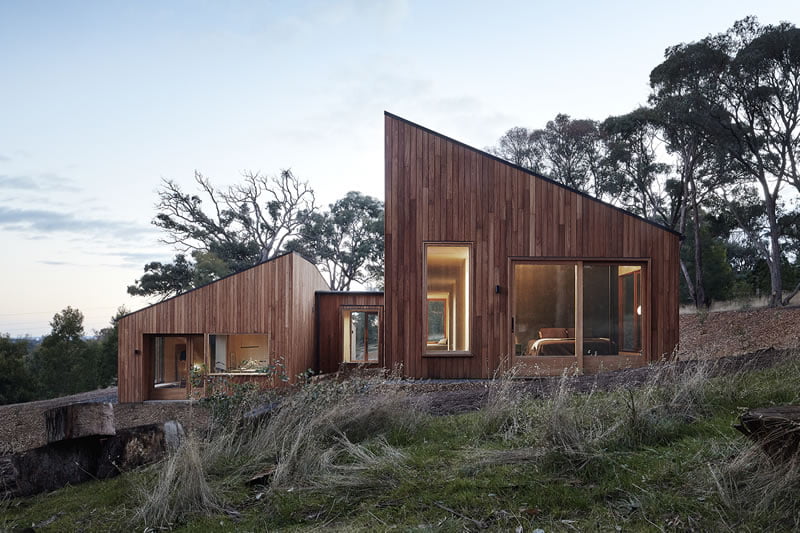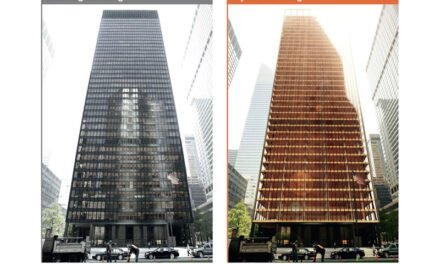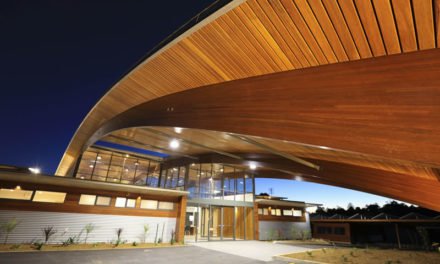Timber cladding combines architectural beauty with a long-lasting, natural, fire-resistant product that brings multiple benefits to the end user without high costs or installation difficulties.
Every building needs a skin. Whether timber-framed domestic residences, or big commercial ventures, it’s the cladding that presents the building’s ‘face’ to the world. Increasingly, clients are considering multiple factors when it comes to that face: appearance is obviously important, but sustainability, maintenance and fire safety all rank highly in the decision-making process.
For Harley Graham, founder and creative director at Byron-based Harley Graham Architects (HGA), that process often leads to timber as an answer. “We’re an emerging architecture firm that deals with warm, earthy modernism,” Graham says. “The materiality of the building is very important to us, and how it sits in the site. More and more, we’ve been looking towards cladding our buildings in dark colours and especially in recycled timber.”
HGA has won commissions around the country and engages with clients strongly on materials choice. “They’re using timber for multiple reasons,” says Graham. “It’s the look, the ease, the embodied carbon sequestered in the wood, that it’s both recyclable and often recycled… We buy a lot of our timber recycled from Kennedy’s Timbers, so it’s not a huge transport cost – Brisbane is essentially local for us. People appreciate the fact it’s a natural product, and there aren’t many natural products that are maintenance free.”
Graham describes taking clients to the Kennedy’s yard and picking through stock “like kids in a candy store”.
But it’s the results that have driven client satisfaction: “We’re buying old bridges and wool stores, usually ironbark, that have been milled down into large-format weatherboard cladding,” he says. “We can put that up on a building with stainless steel screws and we’re done. So many clients are asking for low-maintenance buildings and we can use this recycled timber, put it straight up on the facade and it’s done forever.”
Graham isn’t the only architect who’s been buying cladding from Kennedy’s. “We’re seeing brilliant uses of our product,” says Michael Kennedy. “A lot of commercial buildings are using it over concrete and steel structures to soften the building into the landscape. We’ve just done a job on The Lindis lodge in Waitaki, New Zealand where they used it on the roof of a resort structure to look like a rolling hill. It’s just gorgeous.”
He agrees with Graham that the explosion of timber cladding is driven by much more than looks. “Wood outranks every other building material by a significant margin when it comes to the environment,” Kennedy says. “But on top of that is the fact that it’s durable, it’s fire resistant and – the thing we’re seeing now, particularly in commercial applications, is what’s termed the biophilia effect of using timber. Essentially, it makes you feel good. Research shows kids learn more in schools, people feel happier in offices and homes, and customers buy more in cafes, bars and retail spaces that have a lot of timber in them.”
Kennedy says that even a thin veneer is enough to trigger the effect. “You can have the cladding just 4mm thick inside. So it doesn’t take up space, but you’ll sell more product and, if you’re using different profiles, it will help soften and absorb sound.”
The look that lasts
For builders and clients who want to keep the natural colour of the timber rather than let it grey off, a wide range of natural and tinted coatings are available to retain the look or add colour or other protection. Many suppliers pre-coat cladding, but new formulations make it easy for even DIYers to apply on site if necessary.
“We pre-coat probably 90% of our products,” says Kennedy. “Mostly using a penetrative oil – there’s a number of good products on the market from Intergrain, Cutek and Resene. For people who want it to grey off, we might give it a grey tint so you get that aged look early, or we’ll do a Shou Sugi Ban finish, a burnt, charred look, which is popular in Victoria.”
The deep black tones of the charred finish, where the timber is literally burned, are UV and insect resistant, as well as visually arresting. However, the charcoal can rub off onto passers-by. A new water-based product from Intergrain is specifically designed to solve this problem.
“Most people think of timber stains as being translucent,” says Sonia Tousis, senior brand manager at Intergrain. “Our new Intergrain Industrial Solid Timber Stain is different. It provides an opaque effect, so it gives a really intense depth of colour, but, unlike paint, it won’t mask the texture. Instead, it penetrates the timber and provides the opacity and intensity of colour without changing the look, it lets that beautiful charred timber texture come through.”
As well as protecting residents’ clothes, the stain can also be used on standard timbers to provide a rich blackness. “You won’t get the crocodile-skin charred look, but you will get a matt effect with a slight sheen, much like charcoal itself,” says Tousis.
It’s one more in Intergrain’s range of professional finishes designed for cladding, joining NaturalStain and UltraDeck in providing a durable, long-lasting finish.
“UltraDeck is every bit as good for cladding as for decking,“ Tousis says. “It’s a little more transparent, more of a water-based oil-type product. NaturalStain has a bit more pigment through it, so comes in a broader range of colours, from whites and greys to reds and deeper browns, 16 in all. It’s very durable, we’ve had instances with it on cladding for two years untouched and still doing well.”
Generally, Tousis recommends inspecting coated cladding after 12 months to see when it requires touching up. “It’s a very easy process, even for DIYers,” she says. “You can brush or spray it on. For the initial application, the product has been formulated to allow for easy pre-coating in the factory, whether by spray or in a vacuum coating machine or a painting machine like our Ceetec machines. Because it’s a low-VOC product, it makes it safer for the employees to use. When they’re installed on site, pieces just require a touch-up for any cut ends or holes.”
Kennedy says the cost of pre-coating is usually a significant saving overall. “It’s cheaper and faster for people like us to do it in production than to do it on a building site.”
Easy does it
One innovative Australian product combines the best qualities of standard timber cladding with the ease of panelised cladding.
Weathertex chips, pulps and presses sustainably grown hardwoods with 3% natural wax to make boards and panels that come in a multiple board or ‘groove’ widths, with a range of smooth or textured finishes, in Natural or Primed ready for painting.
Vanda Correia, national marketing manager for Weathertex, says both builders and specifiers find the range attractive. “For builders, it’s lightweight and easy to cut and install. You don’t need special tools and, especially for the panelised product, they can finish projects much faster than if they use something like fibre cement.
“When it comes to specifiers, our Natural range was the first manufactured product to get Platinum Global Greentag certification in the world. That’s their highest rating and it assesses the whole lifecycle, from sourcing timber right through to the waste at the end. Our product is basically two ingredients: hardwood and wax, but the sugars and starches are removed during manufacture, which means termites aren’t interested.”
The large panels come in sizes up to 3.66m, which makes them quick to install and minimises waste.
“Our Natural product doesn’t have to be sealed, it can be left as it is and it will start silvering off like traditional timber. It has a 10-year warranty not to rot, crack or split,” says Correia. “Our Primed products have a 25-year warranty, but the Natural has only been on the market for 10 years so far.”
A raft of fixing options, including systems that automatically align the boards, means builders don’t need specialists to install the product. As Correia says, “With Primelok, it’s almost impossible to screw it up if you use our accessories and the starter strip.”
The ease of use has seen the panel product also become popular for internal applications, which has driven the release of a new, on-trend option. “We recently launched the Weathergroove 75mm, which is a panel with a thinner groove,” says Correia. “That’s taken off very quickly, and we have it in the Natural as well as the Primed Smooth. We made a conscious decision to make it work for both builders and interior designers and we’re pushing at both ends, whereas in the past we predominantly focused on our product as an external facade.
“The demand for internal use product is coming from the end user – people like the textures internally, they like breaking away from a plain painted wall.”
As with classic timber cladding, Correia points out that Weathertex timber products are extremely low-maintenance. “People sometimes assume timber requires work, but as long as you have breathable sarking underneath – that deters mould – and you put a little thought into the whole system, including the insulation, it all works brilliantly together to create a home that is comfortable as well as aesthetically pleasing.”
Vertical grooves are proving another strong trend with both architectural specifiers and builders, but Correia says that there is a lot more variety on show when it comes to cladding than in the past. “Mixing profiles is a big thing. Using the vertical as well as the horizontal, using the Primed with the Natural, or even using the Natural with brick, natural stone or stacked stone.”
Tousis agrees. “Timber cladding has become a bit of an architectural star, whether that’s in bold boards as with Moloney Architects’ Two Halves House, or with a play of textures, such as those in the Marrickville Courtyard House by David Boyle. It’s incredibly versatile, outside and in.”
Low risk option
These days, the words cladding and timber both bring up fire concerns for the lay person, but timber is vastly less flammable than many common cladding materials.
“Our panels and boards are rated to BAL-19,” says Correia, “which is great for most urban use. Timber is combustible, but it burns more slowly than many other building materials, and very predictably.”
Other hardwoods have even higher BAL ratings. “We use a lot of ironbark and tallowwood,” says Graham. “They’re two of the set that rate BAL-29, so we help consumers understand what that means.”
The higher rating means buildings are able to resist ignition at heat up to 29kW/m2, improving the chance of making it through a fire event. More importantly, timber burns slowly, unlike synthetic cladding options.
“It’s a product that rewards throughout its whole lifecycle,” says Graham. “We’ve just put up houses at Wategos Beach where the ironbark came out of some woolstores out west. That’s part of those houses’ story now, but if the time comes when we take them down, that timber can be used again.”
Kennedy agrees: “When timber gets to the end of its life, it’s worth as much in dollar terms as when it went in and you can use it again. It’s a fantastic product.”
For more, visit www.harleygraham.com, www.kennedystimbers.com.au, www.intergrain.com.au or www.weathertex.com.au
Image: Two Halves House by Moloney Architects, photo by Christine Francis, courtesy Dulux.












